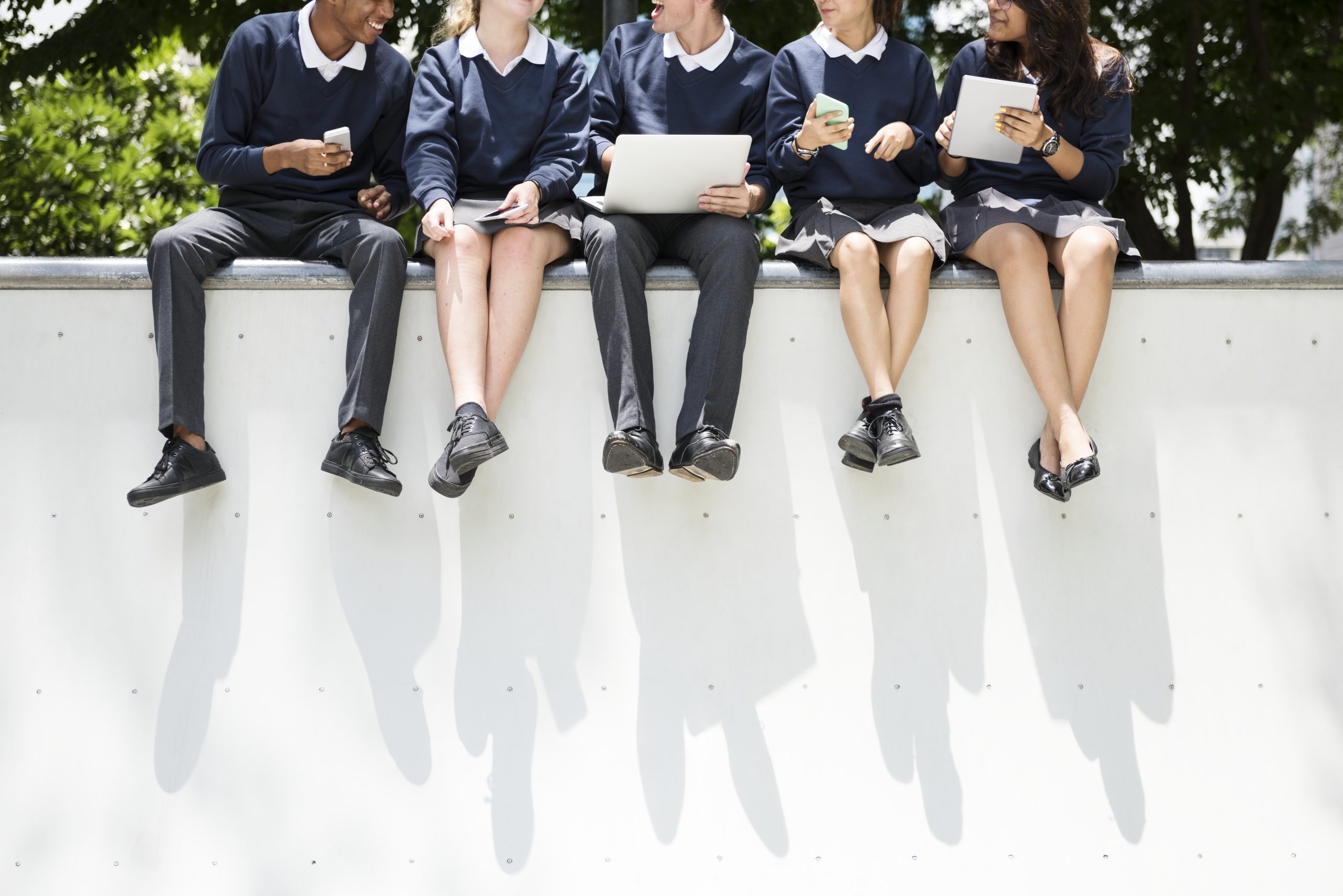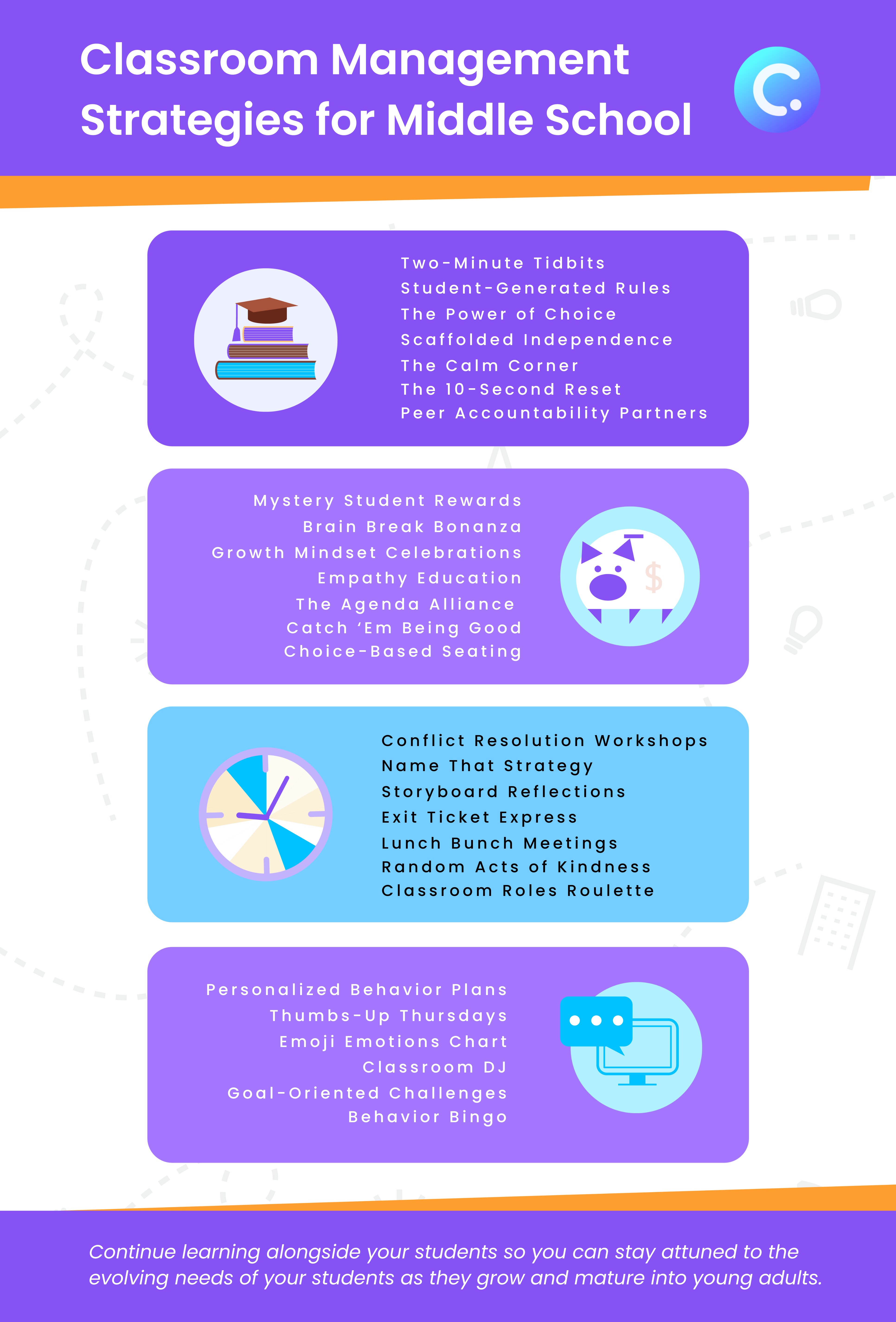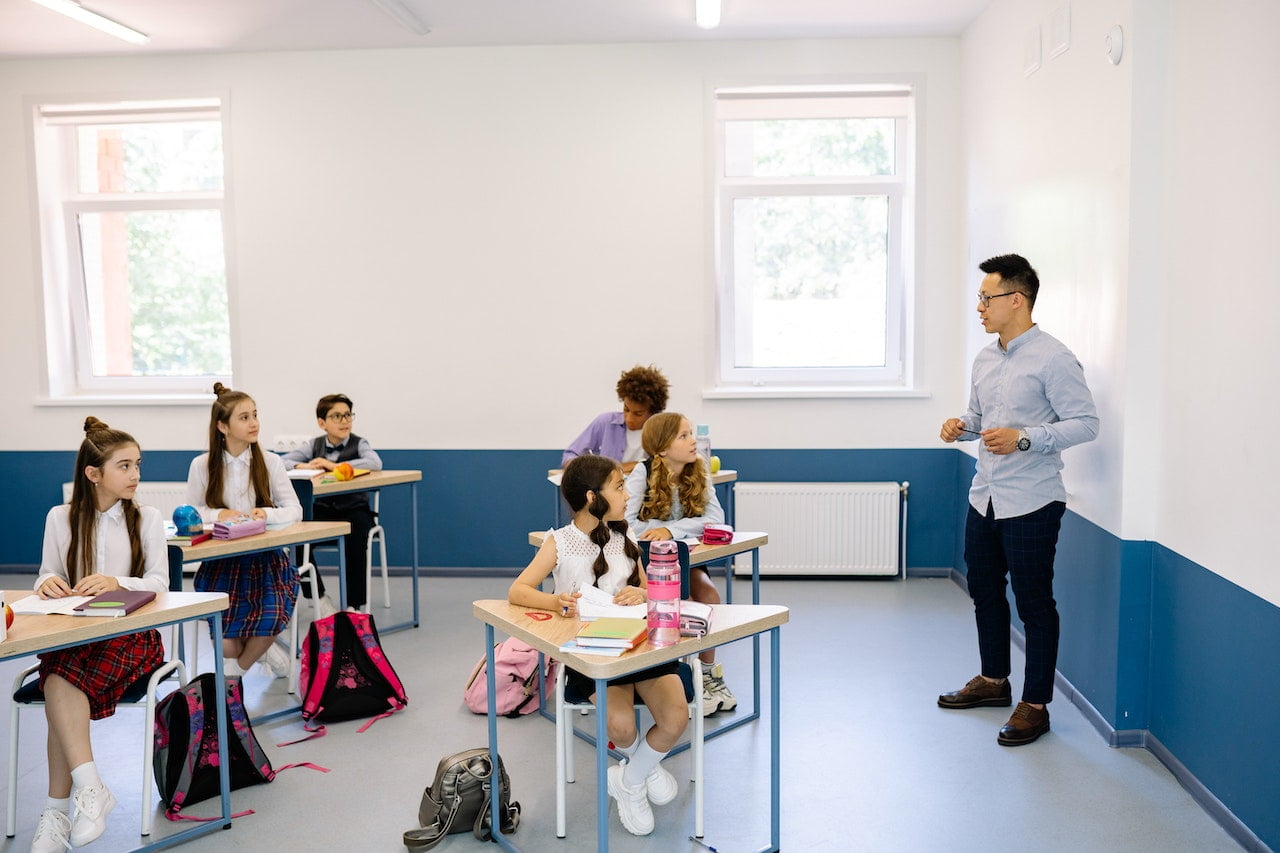Do you ever find yourself pondering questions like:
- How can I maintain order while fostering a dynamic and enjoyable learning atmosphere?
- What are the secrets to keeping my students engaged and excited about the subject matter?
- How can I manage the challenges unique to middle school settings?
Well, you’ve landed on the right page! In this comprehensive guide, we’re going to explore proven effective, and tailor-fit classroom management strategies for middle school teachers. Whether you’re a seasoned educator seeking fresh approaches or a new teacher trying to figure out the art and science of classroom management, our aim is to equip you with a toolbox filled with practical, fun, and 100% doable strategies.
Take note: classroom management strategies for middle schoolers are very different from those employed in early education, and making a misstep can lead to undesirable consequences. So, hop along to see how you can transform your classroom into a thriving hub of motivated students in your middle school classrooms!
Why Classroom Management Strategies for Middle School Plays a Crucial Role
As educators, you’re no strangers to the incredible transformations young minds undergo during the middle school years. This phase marks a pivotal transition from childhood to adolescence, a journey filled with curiosity, self-discovery, and the quest for independence. It’s a time when students begin to test boundaries, question authority, and develop their own identities.
Here’s where classroom management strategies come in:
- Better Personal Growth: Effective classroom management provides a sense of structure and consistency to create a conducive learning environment that allows students to focus on learning and personal growth.
- Academic Progress and Excellence: Well-managed classrooms minimise disruptions and maximize instructional time, facilitating academic progress and excellence at the time when students start tackling more complex and specialised subjects.
- Development of Good Attitudes and Values: Effective classroom management sets the tone for a respectful and positive atmosphere, facilitating the development of good attitudes and values, preparing students towards the real-world.

Navigating the Adolescent Transition: A Pedagogical Challenge
The transition to adolescence is a complex and fascinating process. Middle schoolers are taking their first steps into the world of independence, and are further refining their sense of self and aspirations. This journey can be both thrilling and turbulent. As teachers, you play a crucial role in helping students navigate this transformative period.
Here’s the key:
- Establishing Boundaries
- Transitioning adolescents are naturally inclined to test boundaries and question authority. Effective classroom management acts as a scaffolding of support, providing clear expectations and guidelines for behavior. It creates a safe space for students to explore their newfound independence while respecting the needs of the classroom community.
- Fostering Engagement
- Middle school students crave engagement and relevance. Effectively planned classroom management strategies for middle school students can ensure that lessons remain captivating and meaningful. This not only keeps students focused but also fuels their curiosity and love for learning.
- Building Relationships
- Soon-to-be-adolescents may not readily open up, but they long for connection and understanding. A well-managed classroom fosters positive teacher-student relationships, creating an environment where students feel valued, heard, and supported. This emotional connection can be a powerful motivator.
Benefits of Prioritizing Classroom Management for Middle School
Effective classroom management isn’t just a means to maintain order; it’s a powerful tool that facilitate teaching and support student development at the critical period. Let’s explore some of the key advantages that come with mastering this art:
For Teachers
😌 Reduced Stress and Burnout
Managing conflicts and misbehaviours in middle school can get challenging. When a classroom is well-managed, teachers experience lower levels of stress and burnout. This means you can focus more on the joy of teaching and less on managing disruptive behavior.
🍎 Enhanced Teaching Experience
Classroom management strategies create a more positive teaching environment. This positivity can translate into a more enjoyable teaching experience, which, in turn, can lead to a longer and more satisfying career in education.
💪🏻 Increased Efficiency
With effective management, you’ll spend less time dealing with discipline issues and more time on actual teaching. This increases the efficiency of your lessons and allows you to cover more teaching material, facilitating academic progress.
Enhancing modern-day teaching through effective classroom management strategies can be taken to the next level with the integration of a reliable EdTech solution. Amidst the multitude of options available in the market, allow us to introduce ClassPoint - the #1 audience engagement tool trusted by hundreds of thousands of teachers worldwide. ClassPoint lets you boost your teaching efficiency, giving you access to interactive quizzes, handy slide show tools, gamification features, and even an AI technology. The best part? It's all inside PowerPoint!
For Students
😇 Improved Behavior
As compared to preschoolers, middle schoolers can better understand expectations. Clear expectations and consistent management can effectively lead to improved student behavior. When students know what’s expected of them and understand the consequences of their actions, they are more likely to behave appropriately.
⏳ Increased Learning Time
A well-managed classroom maximizes learning time, which is crucial for especially when students are beginning to grasp more complex concepts and subjects. Students spend less time being distracted or disrupting others, allowing for more time devoted to actual learning and skill development.
💓 Positive Teacher-Student Relationships
Positive teacher-student relationships are important regardless of which education stage you students are at. When students feel respected and supported, they are more likely to engage with the material and seek help when needed.

🤲🏻 Enhanced Social and Emotional Skills
Social and emotional skills are among the topmost sought-after skills in the current workplace. And good classroom management often incorporates social and emotional learning components, ensuring students learn to manage their own behavior and emotions and develop these crucial life skills that extend beyond the classroom.
💼 Preparation for Real-World Challenges
Classroom management teaches students important life skills, such as responsibility, self-control, and conflict resolution. These skills are invaluable as they prepare for future challenges in higher education and the workforce.
Classroom Management Strategies for Middle School Teachers

Teaching middle schoolers can sometimes feel like riding a rollercoaster through a whirlwind of emotions and energy. But fret not; with these unique classroom management strategies, you can not only survive but thrive in this exciting journey.
1. Two-Minute Tidbits
Set aside the first two minutes of each class for students to share something exciting or interesting that happened in their lives. This personal touch not only builds rapport but also channels their morning enthusiasm positively. It helps students start the day on a bright note, reducing potential disruptions.
Why it works: Middle schoolers often come to class bursting with stories. Allowing them to share these stories channels their energy into a constructive and engaging activity.
2. Student-Generated Rules
Instead of imposing classroom rules, involve your students in creating them. Encourage them to brainstorm and discuss rules that they believe will make the classroom a better place for learning. When students have a say in the rules, they’re more likely to abide by them.
Why it works: Middle schoolers crave autonomy and respect. Allowing them to shape the rules empowers them and fosters a sense of responsibility.
3. The Power of Choice

Give students choices whenever possible. Whether it’s selecting a project topic, a reading assignment, or a group partner, choice promotes a sense of ownership and engagement. Middle schoolers appreciate having a say in their learning journey.
Why it works: Middle schoolers are developing their identities and preferences. Providing choices honors their individuality and encourages active participation.
4. Scaffolded Independence
Gradually build students’ independence by scaffolding your expectations. Start with clearly defined steps and then gradually release responsibility as they become more adept. This method helps prevent frustration and empowers students to take ownership of their learning.
Why it works: Middle schoolers are in a transitional phase where they’re seeking more independence. Scaffolding allows them to develop skills without feeling overwhelmed.
5. The Calm Corner

Designate a “Calm Corner” in your classroom where students can take short breaks to refocus when needed. Middle schoolers sometimes struggle with self-regulation, and this space provides them with a quiet, non-punitive area to collect themselves.
Why it works: Middle schoolers can become easily overwhelmed, and a designated calming space helps them manage their emotions and return to class ready to learn.
6. The 10-Second Reset
When you notice that the energy in the room is getting too chaotic or off-track, initiate a “10-Second Reset.” This involves everyone taking a deep breath and refocusing their attention on the task at hand. It’s a quick and effective way to regain control without interrupting the flow of the lesson.
Why it works: Middle schoolers can easily get carried away. The 10-Second Reset provides a gentle reminder to refocus and stay on track.
7. Peer Accountability Partners
Assign students as “accountability partners” for specific tasks or assignments. They work together to ensure each other’s success, fostering a sense of responsibility and teamwork. Knowing that a peer is relying on them can motivate students to stay engaged.
Why it works: Middle schoolers value peer relationships and are more likely to take responsibility when they know their peers are counting on them.
8. Mystery Student Rewards
Select a “Mystery Student” each day without revealing their identity. This student earns a reward (e.g., a small treat or privilege) if they consistently follow classroom rules and demonstrate positive behavior. It adds an element of excitement and encourages everyone to be on their best behavior.
Why it works: Middle schoolers love surprises and friendly competition. The Mystery Student concept keeps them engaged and striving for positive behavior.
9. Brain Break Bonanza
Integrate short brain breaks into your lessons, allowing students to stretch, move, or engage in quick, fun activities. Middle schoolers have energy to spare, and these breaks help them refocus and maintain attention during longer lessons.
Why it works: Middle schoolers have shorter attention spans and need periodic breaks to recharge and stay engaged.
Try using a PowerPoint timer to run a brain break in your class.
10. Growth Mindset Celebrations
Celebrate not only academic achievements but also the effort, perseverance, and growth mindset displayed by students. Recognize and reward their commitment to improvement, which fosters a positive classroom culture.
Why it works: Middle schoolers are at a stage where they’re developing their self-concept. Recognizing effort over outcomes encourages them to embrace challenges.
11. Empathy Education
Dedicate time to teach empathy and emotional intelligence explicitly. Use stories, discussions, and role-play to help students understand and respect each other’s feelings and perspectives. This builds a more empathetic and harmonious classroom.
Why it works: Middle schoolers are navigating social complexities, and teaching empathy helps them build healthier relationships.
12. The Agenda Alliance

Encourage students to maintain daily agendas or planners to track assignments, deadlines, and important dates. This strategy promotes organization, responsibility, and accountability.
Why it works: Middle schoolers are developing organizational skills, and agendas help them stay on top of their responsibilities.
13. Catch ‘Em Being Good
Create a culture of positivity by acknowledging and praising students for good behavior and contributions. Public recognition, such as “Caught Being Good” awards, reinforces desired behavior.
Why it works: Middle schoolers respond well to positive reinforcement and appreciate recognition for their efforts.
14. Choice-Based Seating
Allow students to choose their seats within certain parameters. This choice empowers them and can reduce classroom disruptions related to seating assignments.
Why it works: Middle schoolers often seek autonomy and choice. Giving them control over their seating can lead to a more harmonious classroom.
15. Conflict Resolution Workshops
Teach conflict resolution skills through workshops or classroom discussions. Equip students with tools to resolve disputes peacefully and constructively, reducing disruptions and fostering a supportive classroom environment.
Why it works: Middle schoolers may encounter conflicts, and teaching them resolution skills empowers them to handle these situations maturely.
16. Name That Strategy
Inject creativity into your classroom rules by giving them catchy names. For instance, instead of “Raise your hand to speak,” call it “The Talk Torch.” This playful approach makes adhering to rules more engaging and memorable for middle schoolers.
Why it works: Creative names add an element of fun and curiosity to classroom expectations, making them more appealing.
17. Storyboard Reflections

Encourage students to express their thoughts and feelings through visual storytelling. Have them create storyboards to reflect on their behavior or classroom experiences. This artistic expression fosters self-awareness and creativity.
Why it works: Visual reflection offers an alternative avenue for students to communicate their emotions and experiences.
18. Exit Ticket Express
Incorporate behavior assessment into exit tickets. Include an activity where students rate their behavior during the lesson on a scale from 1 to 5. This self-assessment promotes accountability and provides you with valuable insights.
Why it works: Self-assessment empowers students to monitor their behavior and encourages responsibility.
Exit tickets can be in the form of real-time, interactive writing activities. ClassPoint's Word Cloud and Short Answer can be great tools for you to try out.
19. Lunch Bunch Meetings
Organize occasional lunchtime meetings with small groups of students. Use this informal setting to discuss classroom behavior, challenges, and successes. It creates a supportive and open dialogue, fostering a sense of belonging.
Why it works: Informal meetings build trust, allow students to voice concerns comfortably, and strengthen the teacher-student relationship.
20. Random Acts of Kindness Challenges
Initiate challenges that encourage students to perform random acts of kindness for their peers. Create a challenge board where students can track their acts of kindness. This not only cultivates empathy but also builds a positive classroom culture.
Why it works: Acts of kindness promote empathy, cooperation, and a sense of community.
21. Classroom Roles Roulette
Rotate classroom roles such as line leader, timekeeper, or materials distributor. Use a random selection method like drawing names from a hat. This keeps students engaged, responsible, and eager to contribute.
Why it works: Rotation ensures that all students have the opportunity to take on leadership roles and actively participate in classroom management.
22. Personalized Behavior Plans
Collaborate with students to create personalized behavior plans. Allow them to set their own behavior goals and choose the rewards for meeting them. This empowers them to take ownership of their actions and behavior.
Why it works: Personalized plans increase student motivation, responsibility, and their commitment to achieving behavioral goals.
23. Thumbs-Up Thursdays

Designate Thursdays as a day for students to give a “thumbs-up” to a peer who exhibited exemplary behavior or kindness during the week. This peer recognition fosters positive social interactions and reinforces desired behavior.
Why it works: Peer recognition builds a sense of community, encourages positive behavior, and reinforces classroom norms.
24. Emoji Emotions Chart
Introduce an “emoji emotions chart” where students indicate their emotional state at the start of the day or class. This provides valuable insights into their emotional well-being and allows you to tailor your teaching accordingly.
Why it works: Understanding students’ emotions enables you to create a supportive and empathetic classroom environment, reducing potential disruptions.
25. Classroom DJ
Allow students to take turns as the “Classroom DJ.” They can select background music during work periods, fostering a positive and productive atmosphere. Encouraging them to create playlists can also be an engaging activity.
Why it works: Music enhances focus, motivation, and a sense of ownership over the classroom environment.
26. Goal-Oriented Challenges
Set class-wide behavior challenges with specific goals. For instance, if the class achieves a predetermined number of behavior points, they earn a special reward or privilege. This approach promotes teamwork and motivation.
Why it works: Goal-oriented challenges encourage cooperation, teamwork, and a sense of accomplishment.
27. Behavior Bingo
Create a “Behavior Bingo” card featuring various positive behaviors (e.g., helping a classmate, participating actively). When students achieve a line or pattern on their Bingo card, they earn a reward. This gamified approach keeps behavior expectations engaging.
Why it works: Behavior Bingo transforms positive behavior into a game, making it enjoyable and rewarding.
Bonus: Best Practices to Successfully Implement Classroom Management Strategies For Middle School

🎵 Harmonious Routines
Like a symphony, maintain consistent rhythms in your classroom activities. These routines help students know what to expect, allowing them to focus on learning instead of anticipating disruptions.
🚧 Crystal-Clear Boundaries
Paint your classroom rules on the canvas of clarity. Craft straightforward expectations that leave no room for guesswork, ensuring everyone knows the melody of behavior.
🔄 Adaptability Alchemy
Be a maestro of adaptability. Flexibility, like a skilled improvisation, allows you to fine-tune your strategies according to the ever-changing dynamics of your classroom.
☀️ Radiate Positivity
In your classroom, be the sun that brightens the day. Shine positivity on your students, nurturing an environment where rays of encouragement and praise overshadow shadows of negativity.
🌱 Relationship Gardens
Cultivate connections like a seasoned gardener. Nurture relationships with your students, tending to their growth and well-being like precious blooms.
👂 Listen Actively, Empathize Deeply
Tune your ears to the symphony of your students’ voices. Practice active listening and empathetic understanding to harmonize with their needs and emotions.
📊 Strategy Assessment Expedition
Embark on regular journeys of strategy assessment. Evaluate the effectiveness of your methods, adjusting your course to navigate uncharted waters with wisdom.
🎶 Student Voice Symphony
Be the conductor of collaboration, and your involve students in the creative composition of your classroom management. Let their voices harmonize with your strategies for a symphony of success.
🔄 Reflection Odyssey
Take introspective voyages into your teaching experience. Reflect on the crescendos of achievement and the gentle decrescendos of challenges, constantly learning from each note.
🏝️ Self-Care Oasis
Amidst the whirlwind of education, create an oasis of self-care. Replenish your spirit, ensuring you remain a radiant lighthouse guiding your students through the seas of knowledge.
Conclusion
Middle school represents a critical transition phase between early education and tertiary education. You will almost certainly be presented with a new set of challenges and opportunities each day.
However, we trust that the classroom management strategies for middle school we are sharing will prove invaluable. And a gentle reminder to all middle school teachers: continue learning alongside your students so you can stay attuned to the evolving needs of your students as they grow and mature into young adults.
May your commitment to effective classroom management continue to provide structure and support for your students, creating an environment where learning thrives. With each passing day, you contribute to the growth and development of the next generation. 💪🏻
